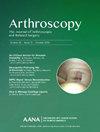Postoperative Decrease in Bone Marrow Lesion Associated With Better Clinical Outcomes Following Medial Open-Wedge High Tibial Osteotomy
IF 4.4
1区 医学
Q1 ORTHOPEDICS
Arthroscopy-The Journal of Arthroscopic and Related Surgery
Pub Date : 2024-10-01
DOI:10.1016/j.arthro.2024.01.032
引用次数: 0
Abstract
Purpose
To assess serial changes of preoperative bone marrow lesion (BML) following medial open-wedge high tibial osteotomy (MOWHTO) up to 2 years and evaluate whether postoperative change of BML affected patient-reported outcome measures (PROMs) at 2 years’ follow-up. Factors related to the postoperative changes in BML also were evaluated.
Methods
The current study retrospectively assessed prospectively collected data of consecutive patients between December 2016 and March 2018 who underwent MOWHTO for symptomatic knee osteoarthritis with varus malalignment (≥5°) and a minimum 2-year follow-up. Serial magnetic resonance imaging scans at preoperative and postoperative 3, 6, 18, and 24 months were performed, and the extent of BML was evaluated consecutively using 2 validated methods. Clinically, preoperative and postoperative PROMs and their achievement of minimal clinically important difference values were evaluated. The associations of the extent of BMLs with PROMs at each follow-up period over time were analyzed using a linear mixed model. Furthermore, factors related to the postoperative changes of BML were assessed.
Results
Of 26 patients, 21 (80.8%) had preoperative BML at medial femoral and tibial condyles. The postoperative decrease in BML was noted in 17 (81.0%) and 18 (85.7%) at medial femoral and tibial condyles. The BML decreased at postoperative 3 months and, thereafter, the extent of BML gradually reduced until postoperative 24 months. The proportion of patients achieved minimal clinically important difference was 84.6% for total Western Ontario and McMaster Universities Osteoarthritis Index scores and 80.8%, 76.9%, and 84.6% for KOOS symptom, pain, and activity of daily living subscales. Postoperative decrease in BML was significantly associated with better PROMs over postoperative 24 months. Furthermore, normo-correction (2°-5° valgus) was a significant factor for decreased BML following MOWHTO.
Conclusions
Preoperative BML gradually decreased with time following MOWHTO, and the postoperative decrease in BML related with better PROMs over postoperative 24 months. Moreover, postoperative valgus alignment was a significant factor relating the postoperative decrease of BML.
Level of Evidence
Level IV, retrospective case series.
胫骨内侧开刃高位截骨术后骨髓病变的减少与更好的临床疗效相关。
目的:本研究旨在评估内侧开楔高胫骨截骨术(MOWHTO)术后2年内骨髓病变(BML)的序列变化,并评估BML术后变化是否会影响随访2年的患者报告结局指标(PROMs)。同时还评估了与术后 BML 变化相关的因素:本研究回顾性评估了前瞻性收集的2016年12月至2018年3月期间连续接受MOWHTO的患者数据,这些患者因症状性膝骨关节炎伴膝关节外翻错位(≥5°)而接受了MOWHTO手术,并接受了至少2年的随访。在术前和术后 3、6、18 和 24 个月进行序列 MRI 检查,并使用两种经过验证的方法连续评估 BML 的范围。在临床上,对术前和术后的 PROMs 及其最小临床重要差异(MCID)值进行了评估。采用线性混合模型分析了 BML 的程度与各随访期 PROMs 的相关性。此外,还评估了与 BML 术后变化相关的因素:26名患者中,21人(80.8%)术前股骨内侧和胫骨髁处有BML。术后股骨内侧髁和胫骨内侧髁BML下降的分别有17人(81.0%)和18人(85.7%)。术后 3 个月,BML 有所下降,此后,BML 范围逐渐缩小,直至术后 24 个月。WOMAC总分达到MCID的患者比例为84.6%,KOOS症状、疼痛和日常生活活动分量表达到MCID的患者比例分别为80.8%、76.9%和84.6%。术后 BML 的降低与术后 24 个月内 PROMs 的改善有显著相关性。此外,正常矫正(2°-5°外翻)是 MOWHTO 术后 BML 下降的一个重要因素:结论:MOWHTO术后,术前BML随着时间的推移逐渐减少,术后BML的减少与术后24个月内PROM的改善有关。此外,术后外翻对位是术后BML下降的一个重要因素。
本文章由计算机程序翻译,如有差异,请以英文原文为准。
求助全文
约1分钟内获得全文
求助全文
来源期刊
CiteScore
9.30
自引率
17.00%
发文量
555
审稿时长
58 days
期刊介绍:
Nowhere is minimally invasive surgery explained better than in Arthroscopy, the leading peer-reviewed journal in the field. Every issue enables you to put into perspective the usefulness of the various emerging arthroscopic techniques. The advantages and disadvantages of these methods -- along with their applications in various situations -- are discussed in relation to their efficiency, efficacy and cost benefit. As a special incentive, paid subscribers also receive access to the journal expanded website.

 求助内容:
求助内容: 应助结果提醒方式:
应助结果提醒方式:


